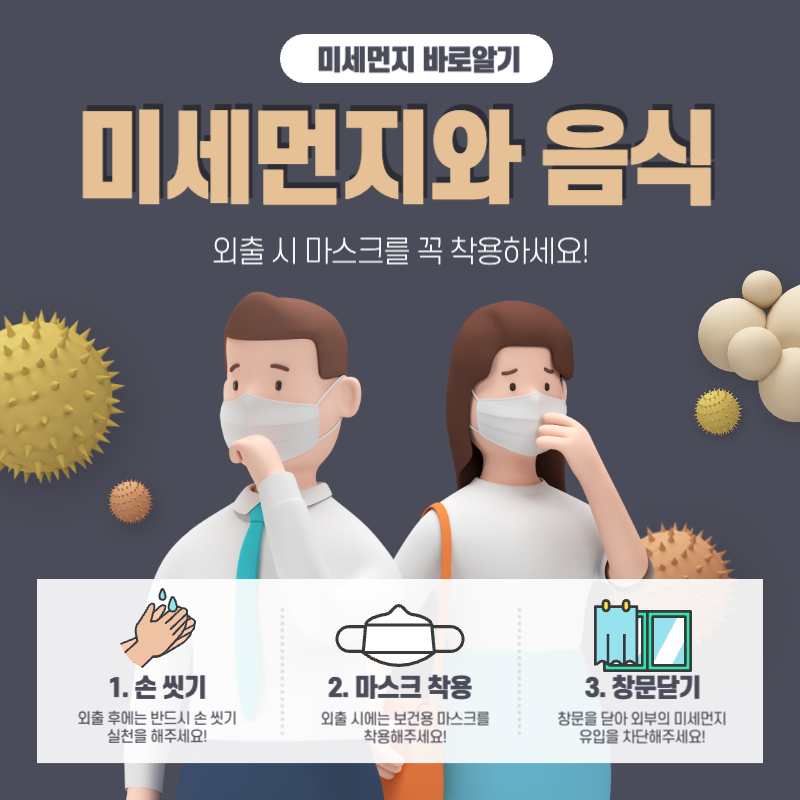The season of fine dust has returned. April in South Korea often feels like spring is not a pleasant time due to the high levels of fine dust. Today, I'd like to talk about foods that are good for the body and effective methods to combat fine dust.
1. War on fine dust
On days with high levels of fine dust, special care is required. Proper mask wearing, maintaining cleanliness after going outside, and even when indoors, brief ventilation for 1-3 minutes are essential, along with proper mask wearing.
Even if we follow all the above rules, we cannot completely prevent fine dust from being absorbed into our bodies. Therefore, Consume plenty of fruits and vegetables rich in water and vitamin C to increase waste excretion and antioxidant effects.This is good.
2. 5 Foods That Help Eliminate Fine Dust
In April, Korea's spring season, when fine dust levels are high, let's learn about foods that can protect our bodies and reduce damage from fine dust.
The foods below are effective in preventing problems caused by fine dust and helping to expel fine dust from the body.
Water
- Water is the most basic element for expelling fine dust from our bodies. Sufficient water intake is essential for preventing the occurrence of fine dust. Prevents dryness and effectively removes toxins and fine dust from the bodyI'll order it.
- It is recommended to drink 1.5 to 2 liters of water per day, and on days with high levels of fine dust, it is recommended to drink more water than usual.
Water parsley
- Water parsley is a very healthy food that helps remove heavy metals from the body and promotes detoxification. It can also help with respiratory problems caused by fine dust.
- Minari is best eaten raw, lightly blanched, or in a side dish or salad.
Balloon flower
- Platycodon grandiflorum is known to be very beneficial for bronchial health and is effective in treating respiratory problems caused by fine dust. Platycodon grandiflorum is actually used to remove phlegm and relieve coughs.
- You can eat doraji raw, drink it as tea, or cook it as doraji salad.
Marine plants
- Seaweed contains a compound called arginine, which helps eliminate heavy metals from the body. Foods like laver, wakame, and kelp are particularly effective at reducing the damage caused by fine dust.
- Seaweed is good to consume in a variety of dishes, such as soups, stews, and salads.
green tea(Green tea)
- The catechins contained in green tea help eliminate heavy metals from the body and strengthen the immune system. Green tea is also known for its antioxidant properties, making it effective in reducing cell damage caused by fine dust.
- Green tea is good for your health, but if you consume too much, it can cause side effects such as diarrhea, constipation, and insomnia. If you drink it on an empty stomach, it can cause heartburn, so you should consume it with caution.

3. Misconceptions about fine dust
- Is China the cause of fine dust?
- It is half true and half false to claim that China is the cause of fine dust. Of course, it is also due to China's development and sandstorms. The proportion affecting our country is approximately 40% of the total.is known as.
- In addition, 60% fine dust originates domestically, with nitrogen oxides and ammonia emitted from diesel vehicles being the main constituents. Furthermore, sulfur oxides and nitrogen oxides emitted from thermal power plants, as well as dust from the manufacturing and construction industries, account for a significant portion of the fine dust.
- Pork belly detoxifies fine dust?
- Fine dust is inhaled into the body through the human respiratory system. Therefore, eating foods such as pork belly It does not directly help detoxify and expel fine dust. Rather, consuming water, water parsley, bellflower root, green tea, and seaweed, as mentioned above, is effective in eliminating fine dust.
- There was no fine dust in the past?
- Fine dust has existed in the past as well. In the past, fine dust was created by volcanic eruptions, forest fires, yellow dust, and soil scattering, and after the Industrial Revolution, the increase in coal use began to cause serious air pollution, especially in large cities.
- The 'Great Smog' that occurred in London, England in December 1952, caused more than 4,000 deaths and was an incident that showed that fine dust can have a very fatal effect on human health.
Conclusion
Fine dust plagues us in the spring. Today, we learned about five foods that are good for fine dust and some misconceptions about fine dust.
By accurately understanding and responding to fine dust, which has a significant impact on our environment, we will be able to lead healthier lives.
